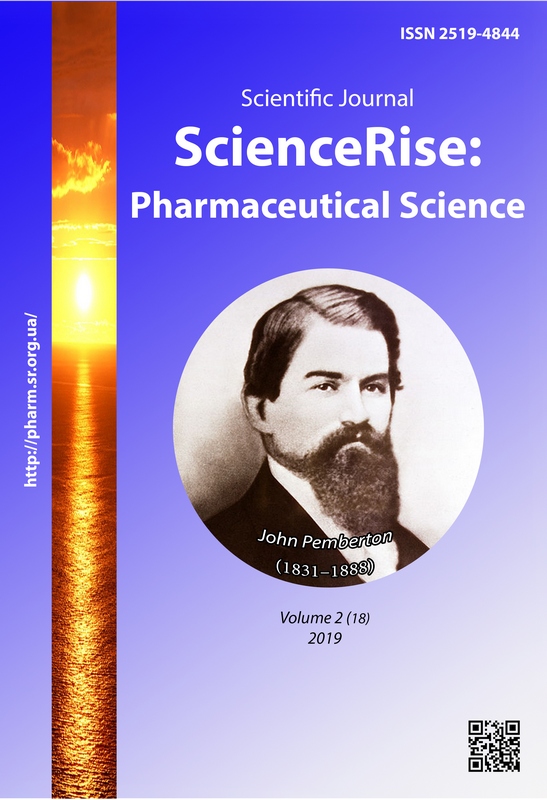Розробка методики одночасногокількісного визначення лоратадину тадопоміжних речовин у комбінованому сиропі «Лоратадин+»
DOI:
https://doi.org/10.15587/2519-4852.2019.169511Ключові слова:
лоратадин, метилпарагідрокисбензоат, пропілпарагідрокси¬бензоат, кількісне визначення, комбіновані засоби, гепатозахиста діяАнотація
Мета. Метою представленого дослідження була розробка методики одночасного визначення лоратадину та допоміжних речовин – метилпарагідроксибензоату та пропілпарагідроксибензоату в комбінованому сиропі «Лоратадин+» у присутності ласкавця золотистого трави екстракту.
Матеріали і методи. Liquid chromatography separation was performed using a Shimadzu Nexera X2 LC-30AD HPLC system (Shimadzu, Japan) composed of a quaternary pump, an on-line degasser, a column temperature controller, the SIL-30AC autosampler (Shimadzu, Japan); the CTO-20AC thermostat (Shimadzu, Japan) as well as the SPD-M20A diode array detector (DAD).
Результати і обговорення.Ідентифікацію основного компоненту та домішок у комбінованому засобі проводили шляхом визначення часів утримування піків лоратадину, метилпарагідроксибензоату і пропілпарагідроксибензоату на хроматограмі випробовуваного розчину, одержаній при їх кількісному визначенні, які співпадали з часами утримування відповідних піків на хроматограмі розчину порівняння.
При розробці методики кількісного визначення встановлено, що з використанням градієнтного режиму спостерігалось краще розділення між сполуками, коефіцієнт розділення між піками метилпарагідроксибензоату та найближчих до нього піків став більшим ніж 2.5, у випадку пропілпарагідроксибензоата цей показник становив більше 3.
Для підтвердження коректності запропонованого методу було проведено валідаційні дослідження згідно з вимогами ДФУ. Встановлено, що невизначеність пробопідготовки становить для лоратадину – 1,5 %, для метилпарагідроксибензоату – 1,47 %, для пропілпарагідроксибензоату – 1,53 %, що не перевищує критерії прийнятності. Специфічність методики підтверджена шляхом порівняння хроматограмрозчину порівняння, випробовуваного розчину і хроматограми бланк-розчину. Вимоги до лінійності методики виконувалися на всьому діапазоні концентрацій для лоратадину і обох допоміжних речовин. Коефіцієнти кореляції становили 0,9999, 0,9999 та 0,9995 відповідно. Правильність методики виконувалась за двома критеріями – практичною та статистичною незначущістю, що були визначені в ході експериментальних досліджень. Результати оцінки внутрішньолабораторної прецизійності показали відповідність одержаних значень довірчого інтервалу середнього результату критерію прийнятності. За результатами визначення робасності встановлено, що для оптимальних умов хроматографування можна використовувати свіжоприготований розчин порівняння протягом 24 год.
Висновки. Розроблена методика одночасного кількісного визначення лоратадину та допоміжних речовин – метилпарагідрокисбензоату та пропілпарагідроксибензоату у сиропі комбінованому «Лоратадин+». Визначено умови, що дозволяють коректно визначити всі компоненти в присутності екстракту ласкавця золотистого трави. Коректність методики підтверджено валідаційними дослідженнями
Посилання
- Arshad, H., Khan, A., Assad, U., Kittaneh, M., Berkelhammer, C. (2016). Antihistamine-Induced Hepatitis: 2 Cases Involving Loratidine. Case Reports in Hepatology, 2016, 1–2. doi: http://doi.org/10.1155/2016/6890313
- Breidak, O. O., Kuzminov, O. B. (2015). Otsinka kumuliatyvnoi aktyvnosti diazolinu, loratydynu ta dezloratydynu u pidhostromu ekspyrementi na bilykh myshakh. Biolohiia tvaryn, 17 (4), 178.
- Gubergic, N. B., Fomenko, P. G., Lukashevich, G. M., Golubova, O. A. (2012). Farmakoterapevticheskie effekty i klinicheskie vozmozhnosti etalonnogo preparata silimarina. FARMATЕKA, 2, 24–31.
- Pegova, R. A., Vorobeva, O. A., Kolchik, O. V., Bolshakova, A. Е., Zhilcova, O. Е., Melnikova, N. B. (2014). Rastitelnye masla. Sostav i perspektivy ispolzovaniia masla semian tykvy Cucurbita Pepo v terapii (obzor). Medicinskii almanakh, 2 (32), 127–135.
- Asadi-Samani, M., Kafash-Farkhad, N., Azimi, N., Fasihi, A., Alinia-Ahandani, E., Rafieian-Kopaei, M. (2015). Medicinal plants with hepatoprotective activity in Iranian folk medicine. Asian Pacific Journal of Tropical Biomedicine, 5 (2), 146–157. doi: http://doi.org/10.1016/s2221-1691(15)30159-3
- Zhuravlova, L. V., Kryvonosova, O. M. (2013). Porivnialna kharakterystyka hepatoprotektornykh zasobiv: kliuch do ratsionalnoho zastosuvannia. Suchasna hastroenterolohiia, 4 (72), 35–41.
- Thompson, M., Jaiswal, Y., Wang, I., Williams, L. (2017). Hepatotoxicity: Treatment, causes and applications of medicinal plants as therapeutic agents. The Journal of Phytopharmacology, 6 (3), 186–193.
- Majee, C., Mazumder, R., Choudhary, A. N. (2019). Medicinal plants with anti-ulcer and hepatoprotective activity. International Journal of pharmaceutical sciences and research, 10 (1), 1–11. doi: http://doi.org/10.13040/ijpsr.0975-8232.10(1).1-11
- Deshwal, N., Sharma, A. K., Sharma, P. (2011). Review on hepatoprotective plants. International Journal of Pharmaceutical Sciences Review and Research, 7 (1), 15–26.
- Jehangir, A., Nagi, A. H., Shahzad, M. S., Azam, Z. (2010). The hepatoprotective effect of Cassia fistula leaves in Isoniazid and rifampicin induced hepatotoxicity in rodents. Biomedica, 26, 25–29.
- Björnsson, E. (2016). Hepatotoxicity by Drugs: The Most Common Implicated Agents. International Journal of Molecular Sciences, 17 (2), 224. doi: http://doi.org/10.3390/ijms17020224
- Naboka, О. І., Khouari, S., Glushchenko, А. V., Georgiyants, V. A. (2014). Antioxidation properties of extracts of aerial part of Bupleurum aureum, Hill-growing soltword herb, Fumaria Schleicheri and Cynara scolymus in vitro and in vivo Journal of Chemical and Pharmaceutical Research, 6 (7), 172–177.
- Glushchenko, A., Vladymyrova, I., Georgiyants, V. (2018). The substantiation of the selection of medicinal plants and their rational application in diseases of the hepatobiliary system. ScienceRise: Pharmaceutical Science, 2 (12), 9–16. doi: http://doi.org/10.15587/2519-4852.2018.129642
- Glushchenko, A. V., Puliaev, D. S., Georgiianc, V. A., Naboka, O. I. (2016). Sposob vvedeniia sukhogo ekstrakta volodushki zolotistoi v sirop «Loratadin». Vestnik farmacii, 4 (74), 6–9.
- Korobko, D. B., Poliak, O. B., Lohoida, L. S., Zarivna, N. O., Semianiv, O. V. (2014). Rozrobka i validatsiia metodyk identyfikatsii loratadynu v tabletkakh. Aktualni pytannia farmatsevtychnoi i medychnoi nauky ta praktyky, 1 (14), 55–58.
- Florin, A., Grigoriv, I. C., Ciobanu, C. (2016). Validation and Application of a RP-HPLC Method with UV Detection for Loratadine Determination. Revista de Chimie-Bucharest-Original Edition, 67 (6), 1227–1231.
##submission.downloads##
Опубліковано
Як цитувати
Номер
Розділ
Ліцензія
Авторське право (c) 2019 Alla Glushchenko, Ivan Bezruk, Liudas Ivanauskas, Victoriya Georgiyants

Ця робота ліцензується відповідно до Creative Commons Attribution 4.0 International License.
Наше видання використовує положення про авторські права Creative Commons CC BY для журналів відкритого доступу.









